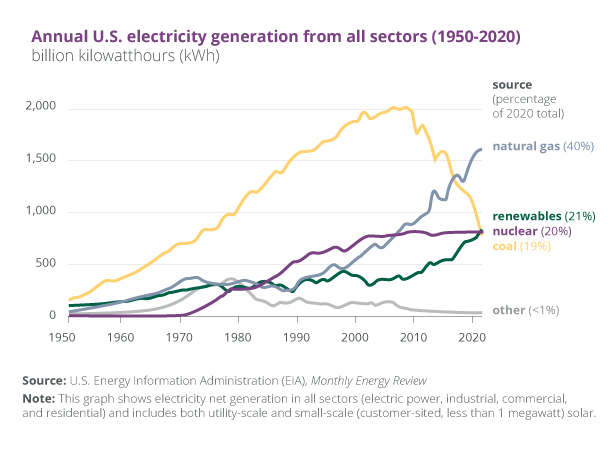02/24/2022
The Evolution of the Power Grid
It is no secret that renewable energy has become one of the main focal points of the utilities industry. The US, along with the rest of the world, is investing in renewables as a way to reduce dependency on fossil fuels, combat climate change, and scale energy production and storage to meet ever growing energy demand. As a result, the US power grid is undergoing a period of transition and evolution.
Let’s examine the current trends in renewables and energy storage on both large and small scales, highlight distributed generation, and take a look at how these will impact the utility industry as the US is integrating renewable electricity on the grid.
Renewable Energy and Storage – Current State and Trajectory
Renewables
In 2020, the second highest electricity production source in the U.S. was renewable energy. This was a record year for renewables as they contributed a total 834 billion KWH of electricity. The image below shows the breakdown of US electricity sources since 1950.

The US Energy Information Administration (EIA) expects renewables to increase dramatically from 834 billion KWH produced in 2020 to almost 2,500 billion KHW in 2050. Electricity demand is also expected to increase; consequently, renewables would account for 42% of overall electricity production in 2050 and surpass natural gas as the largest producer by 2030. Of all renewable sources, solar is expected to make the biggest charge in growth. In fact, solar will account for almost 80% of the growth in renewable production. That growth is supported by several factors, including cost efficiency, paired storage capabilities, and distributed generation via home solar panels.
Energy Storage
Energy storage facilities have been utilized worldwide for decades. As of 2021, the United States has approximately 29 GW of energy storage capacity out of a total 1,200 GW of power generation capacity. The majority (92%) of that storage capacity has been through pumped hydroelectric storage (PHS). PHS is a reliable storage method that will continue to have a place in our grid. However, there are efficiency drawbacks which have limited further investment.



